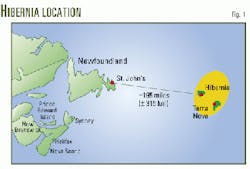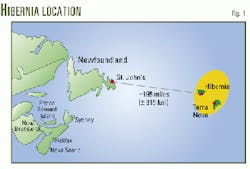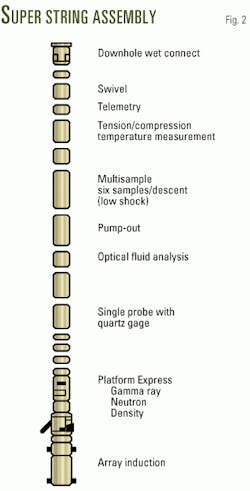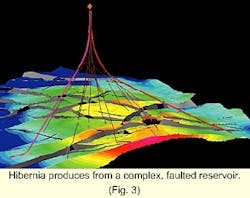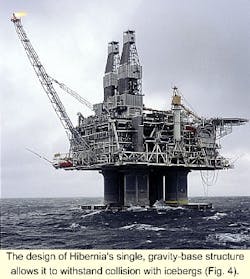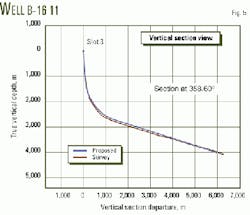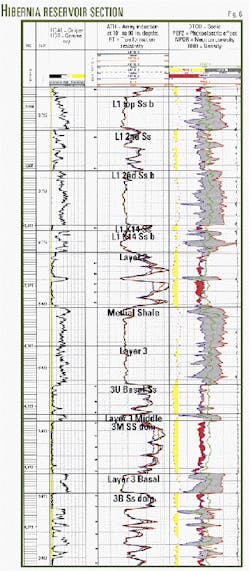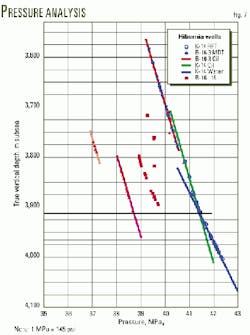Drill-pipe logging string redesign cuts costs for Hibernia
A drill-pipe-conveyed logging string, capable of gathering in one run per well all measurements and fluid samples needed for proper reservoir evaluation, is one of the innovative tools used in developing the Hibernia oil field, offshore eastern Canada (Fig. 1).
Locally called a "superstring," this string (Fig. 2) includes a standard log suite (gamma ray, density, photoelectric effect, neutron porosity, and caliper) with an array induction-resistivity tool. It is capable of acquiring data at multiple investigation depths for oil-water differentiation, and with its modular formation tester, it also can collect reservoir pressure data and PVT (pressure-volume-temperature) quality fluid samples.
The fluid samples facilitate planning, production optimization, and reservoir management.
To maximize recoverability, the complexly faulted Hibernia reservoir (Fig. 3), with more than 30 fault blocks identified to date, requires comprehensive data acquisition for each fault block. Securing such a broad data suite in one run eliminates the inherent risks associated with logging long-reach, high-angle development wells and provides data that is on depth relative to all other log data acquired by the string.
Field operations
The Hibernia field, discovered in 1979, is 195 miles east-southeast of St. John's, Newf. It lies in 260 ft of water on the southwest flank of the Jeanne d'Arc basin, which underlies the northeast portion of the Grand Banks
The Hibernia development includes a 1.2 million-ton, single, gravity-base drilling-production platform (Fig. 4) that was installed in summer 1997, after 6 years of design, engineering, and construction work. A 50-ft thick ice belt protects the platform from icebergs.
The Hibernia owner companies, combined into Hibernia Management & Development Co. (HMDC), are Mobil Oil Canada Properties Ltd. (33.125%), Chevron Canada Resources Ltd. (26.875%), Petro-Canada Hibernia Partnership (20%), Canada Hibernia Holding Corp. (8.5%), Murphy Atlantic Offshore Oil Co. Ltd. (6.5%), and Norsk Hydro Canada AS (5%).
Drilling from the platform commenced in July 1997 and first oil production began Nov. 17, 1997.
The platform initially was designed to handle 150,000 b/d, with a production plateau averaging 135,000 b/d. But because of the higher well productivity encountered, an upgrade to a 180,000 b/d fluid handling capacity is under way.
Production in early 2000 averaged over 140,000 b/d. HMDC estimates the field life to be 18 years, with a recovery of at least 615 million bbl of oil.
The structure has a 1.3 million bbl oil storage capacity. From storage, the oil is transferred to tankers via an offshore loading system.
In conjunction with platform construction, HMDC has developed a supporting infrastructure that includes a heliport, marine base, pipe yard, warehousing, and a platform control-room training simulator.
HMDC operates the field in conjunction with strategic alliances with nine major contractors that provide personnel, materials, and services for the operations. These alliance are with AOC Brown & Root Canada, Hibernia Integrated Well Services (HIWS), led by Schlumberger Oilfield Services, Noble Drilling (Canada) Ltd., ABB Vetco Gray Canada Ltd., East Coast Tubulars Ltd., Baker Petrolite, Harvey & Co. Ltd., Maersk Co. Canada Ltd., and Cougar Helicopters Inc.
Production potential
Hibernia has two principal sandstone reservoirs of early Lower Cretaceous (or Berriasian) age deposited in a fluvio-deltaic system. The sands, Hibernia and Ben Nevis/Avalon, are at average depths of 12,140 and 7,874 ft, respectively, within a south-southwest plunging anticlinal accumulation on the southwest flank of the Jeanne d'Arc basin.
In the field, faults of various types and age have created numerous individual reservoirs. Continuity of the Lower Hibernia reservoir sands across these faults depends on the magnitude of fault offset and reservoir juxtaposition.
Core and log analysis of the predominantly quartz (95-98%), fine to medium-grained Hibernia sandstones indicate reservoir permeabilities in excess of 10 darcies at some locations. Average field porosity measures 17.5%.
Of the 615 million bbl of estimated recoverable oil reserves, HMDC projects about 515 million bbl will come from the Hibernia reservoir, with the remaining 100 million bbl coming from the Ben Nevis/Avalon.
Hibernia produces a light, sweet, 32-34° API crude with 0.4-0.6 wt % sulfur, similar to West African crudes such as Cabinda and Escravos.
In addition to oil reserves, Hibernia also contains about 3.5 tcf of gas in place, which currently is not a sufficient volume to justify building a transportation system for gas sales. HMDC currently reinjects the produced solution-gas that exceeds platform fuel needs. The gas provides pressure maintenance for those portions of the field producing with a gas-drive mechanism.
Logging
Since 1997, HMDC has drilled 15 development wells, with as many as 50 additional wells planned. To date, well trajectories range from 13,125 to 27,903 ft, with 30-90° inclinations.
Well B-16 11 (Fig. 5) is the longest well drilled from the platform to date, reaching a 27,903 ft TD on Feb. 4, 1999. At the time, it was the 13th longest extended reach well in the world and held the North America horizontal displacement record of 20,677 ft.
The industry has proven that logging high-angle wells with wireline is impractical because gravity descent of the tools is not possible in many instances. Another possible risk for wireline work is differentially sticking the modular formation tester, which gathers pressure data and fluid samples.
HMDC determines when to use drill-pipe conveyed logging early in the planning stages of each well. This ensures ample time to design the job and prepare the equipment. In wells with less inclination, HMDC still attempts wireline logging before using drill-pipe-conveyed tools.
To gather all data needed in one logging operation, Schlumberger engineers had to redesign, or rewire, the modular formation tester module so that it could be placed in the middle of the logging string assembly. Previously, it was at the tail end of the string. Also redesigned was the latching mechanism on the bottomhole assembly (BHA).
Maintenance of adequate power during the entire logging operation, which could last for 3 days, was a tough challenge for the new design. This challenge is being met by running a data acquisition sequence that minimizes power usage.
Conducted first are operations requiring the lowest power draw. Next are the higher-risk, greater power-draining steps.
Thus, standard logging (low-power usage) occurs first, followed by the formation pressure readings, which require brief periods of higher power consumption. Fluid sampling, requiring high sustained power, is last.
Drawing fluid as a last step also allows previously acquired data (fluid contacts, hole quality, fluid mobility, etc.) to be used in optimizing the placement of the modular formation tester probe. Planning of the well evaluation occurs long before drilling reaches TD. From the geological, geophysical, and logging-while-drilling (LWD) data, the total number of pressure and fluid samples needed are known about 24-48 hr before running the logging tools.
After drilling reaches TD, the following logging sequence gathers the required data while minimizing total pipe movement and reducing the risk of tool or cable damage:
- Rig-up logging string at surface and attach to drill pipe.
- Run in hole to casing shoe.
- Pump the electric cable downhole and connect it to the logging string.
- Tie log data into cased-hole gamma ray and LWD up hole.
- Run in hole to just above TD and position string to start logging.
- Log upward with neutron-density-induction gamma ray (3 hr).
- Move downward acquiring pressure points (5-10 min/point with an average 23-30 pressures acquired).
- Move upward, acquiring fluid samples (60 min of filtrate pump-out before sampling with an average six samples).
Figs. 6 and 7 illustrate the full data-sample suite obtained in one run during 30-50 hr. Each run of the superstring saved about 48 hr in rig time over the traditional multiple-run approach, or a savings of about $150,000 (Can.)/day in rig costs for each well logged.
The log (Fig. 6) and accompanying pressure gradient evaluation as derived from the formation tester data (Fig. 7) represent a complete Hibernia reservoir section as captured by one logging job with the superstring tool on drill pipe. Layers 2, 3U, 3M, and 3B are massive, high-permeability sandstones. One can easily identify the porous, resistive pay sands from the porosity logs and the multiple depths of investigation provided by the array induction-resistivity data.
HMDC uses the pressure gradient data (Fig. 7), captured by the modular formation tester, to determine fault block connectivity and gas-oil or oil-water contacts. These data help it to target well locations on the structure flanks. The PVT-quality fluid samples help in facility planning and reservoir management.
Outlook
New wireline and LWD technological improvements continually push engineers and geoscientists to adjust their reservoir evaluation programs to suit the best mix of these technologies. The superstring at Hibernia is one example of a localized solution to the ongoing push for increased efficiencies.
At this writing, the Hibernia team continues to look for ways to economize power in the superstring assembly while adding new modules to the tool. One possible addition is a combinable magnetic resonance and dipole sonic tool.
Acknowledgments
The authors thank the Hibernia Management & Development Co. for permission to publish this article.
The authors
Neil Watson recently completed a petrophysical assignment with HMDC and resumed petrophysical duties with Mobil Canada in western Canada. He has been involved in various geological and petrophysical work for Mobil Canada. Watson holds a geology degree with honors from the University of Manitoba.
Brian Stacey leads the well design team on the Hibernia project for Schlumberger. His background includes drilling and completion design and execution for various major operators. Stacey holds a mechanical engineering degree from Memorial University of Newfoundland.
John Mackay is currently operations manager for Schlumberger's Canadian East Coast wireline services. He has been involved in both land and offshore assignments ranging from field engineer to management.
Mackay holds an industrial engineering degree from the Technical University of Nova Scotia.
Tony Fondyga is a petrophysicist on the Hibernia reservoir management team for Schlumberger. His previously has worked in operations, sales, interpretation, and development of new technologies.
Fondyga holds an electrical engineering degree from the University of Toronto.
